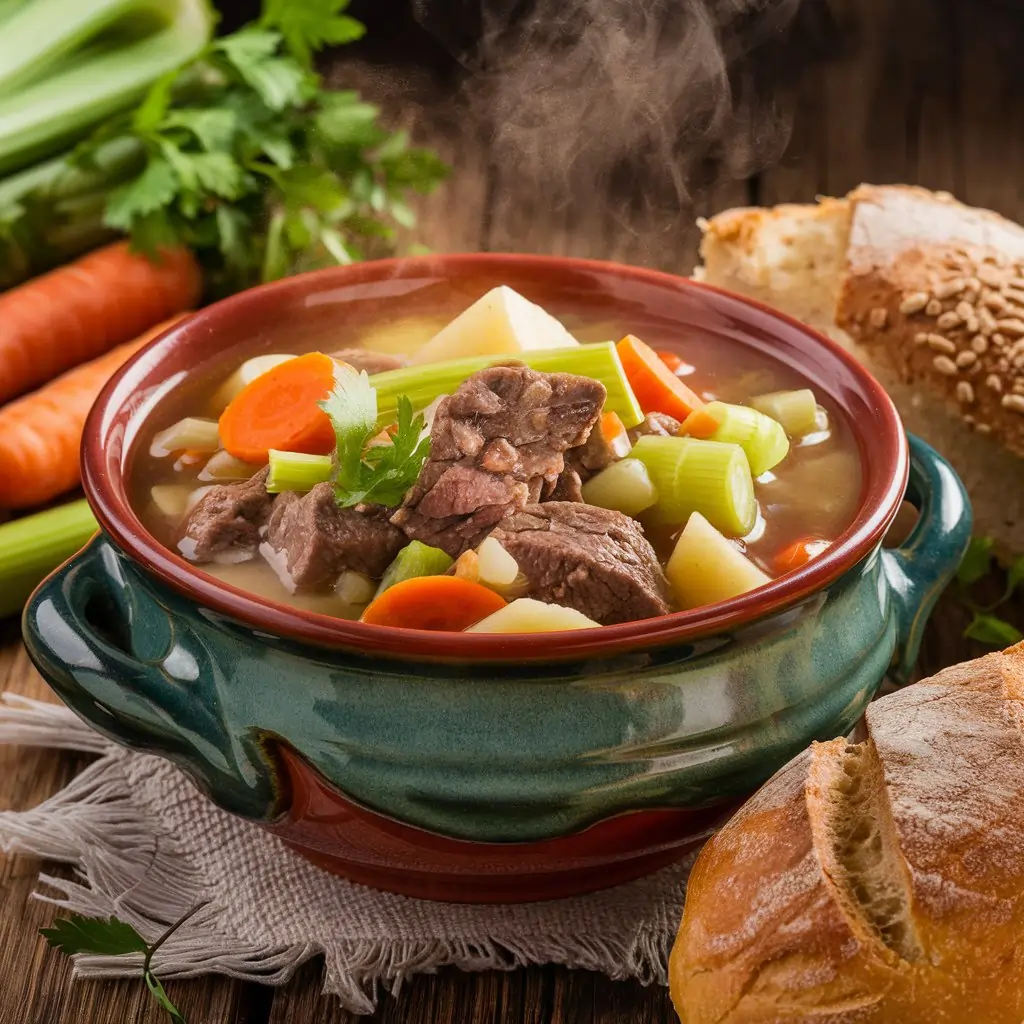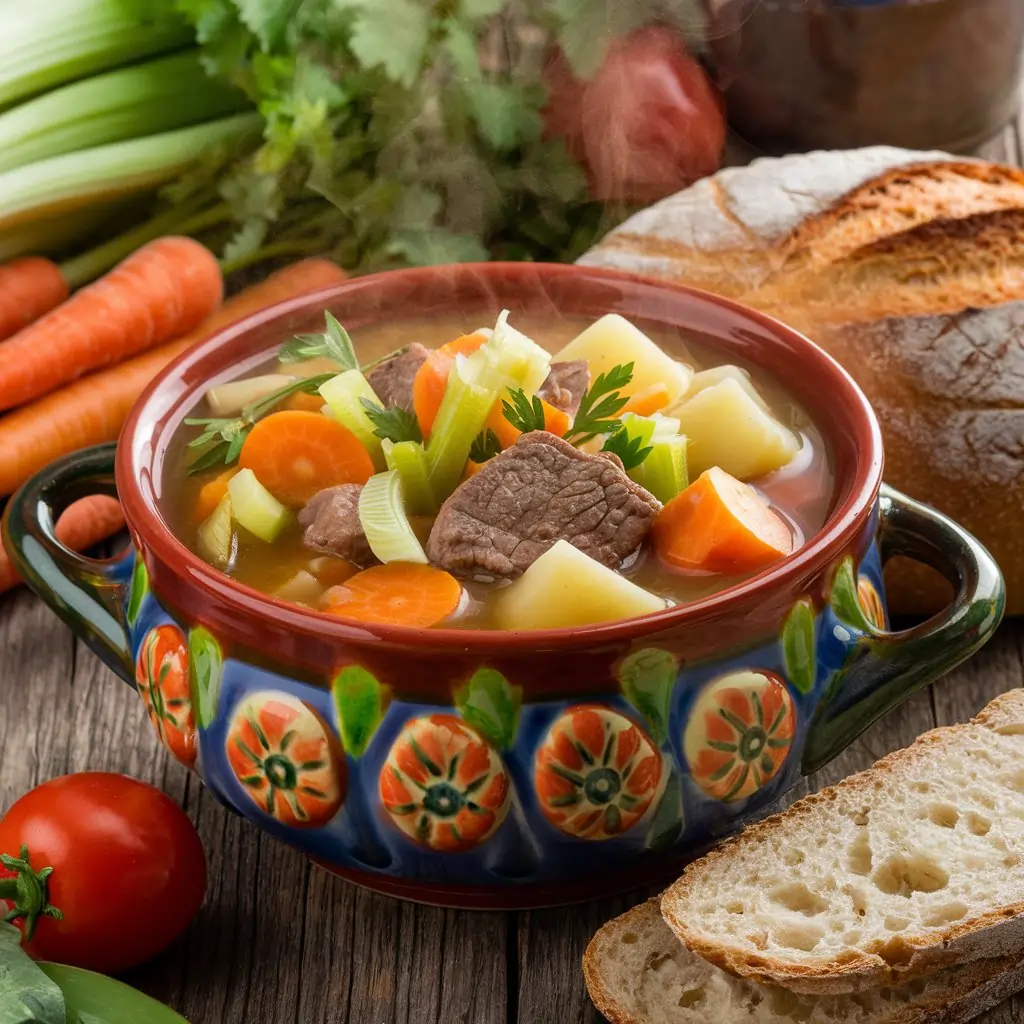Nothing says “home-cooked comfort” quite like a bowl of easy vegetable and beef soup. It’s hearty, nourishing, and incredibly versatile, making it the perfect dish for family dinners, meal prep, or when you just want to cozy up on a chilly day. Whether you’re a seasoned chef or a beginner in the kitchen, this recipe promises to deliver flavors that will make your taste buds dance. So, grab your apron, and let’s dive into the world of simple, yet satisfying, homemade soup!
Table of Contents
The Ingredients for Easy Vegetable and Beef Soup
The foundation of any great soup lies in its ingredients. Here’s a comprehensive guide to everything you’ll need to craft the perfect bowl of vegetable and beef soup.
- The Ultimate Guide to Vegetable Beef Soup
- Best Vegetable Beef Soup recipe
- and Overview of Ground Beef Bulgogi
Choosing the Right Vegetables
Vegetables are the heart of this soup, providing vibrant colors, rich nutrients, and a variety of textures.
Seasonal Vegetable Choices
Using seasonal vegetables not only ensures the freshest flavors but is also budget-friendly. In spring, opt for peas and asparagus. Summer brings zucchini and green beans, while winter is ideal for root vegetables like carrots and parsnips.
Frozen vs. Fresh Options
Short on time? Frozen vegetables are a fantastic alternative to fresh ones. They’re already cleaned and chopped, preserving their nutrients and cutting down your prep time.
Selecting the Best Beef Cuts
The type of beef you choose can elevate your soup from ordinary to extraordinary.
Budget-Friendly Cuts for Soups
Look for beef chuck or stew meat, as these cuts are affordable and become incredibly tender when slow-cooked.
Prepping Beef for Maximum Flavor
Trim any excess fat and cut the beef into even-sized chunks to ensure uniform cooking. A quick marinade with a bit of salt and olive oil can enhance the flavor.
Essential Spices and Seasonings
The magic of any soup lies in its seasoning. Here’s how to master the balance of flavors.
Balancing Flavors with Herbs
Herbs like thyme, rosemary, and parsley bring a fresh aroma to the soup. Don’t forget bay leaves—they work wonders in infusing depth.
Adding Depth with Spices
Spices such as paprika, garlic powder, and a hint of chili flakes can transform the flavor profile of your soup, making it bold and exciting.
Block Quote Example
“Great ingredients make great soup. Use the freshest vegetables and quality beef to ensure every spoonful is bursting with flavor.” 🌟
Step-by-Step Cooking Process
Cooking a delicious vegetable and beef soup isn’t just about tossing ingredients into a pot. It’s an art that requires attention to detail and a bit of technique. Follow these steps for a bowl of perfection every time.
Prepping the Ingredients
Preparation is key to a smooth cooking experience and a well-balanced soup.
Chopping Techniques for Even Cooking
Chop your vegetables into similar-sized pieces to ensure they cook evenly. For instance, dice carrots and celery into small cubes, slice onions thinly, and cut potatoes into medium chunks.
Pro tip: Use a sharp knife to speed up the process and reduce the risk of squashing softer veggies like tomatoes.
Time-Saving Tips for Busy Cooks
Pressed for time? Pre-chop your vegetables the night before and store them in airtight containers in the fridge. Alternatively, purchase pre-cut veggies from the grocery store.
Browning the Beef for Richness
Browning beef is a crucial step for developing deep, savory flavors.
Why Searing Is Essential
When you sear beef, you’re creating the Maillard reaction, a process that caramelizes the surface and locks in flavor. This simple step can elevate the entire soup.
- Heat a large pot or Dutch oven on medium-high heat.
- Add a splash of olive oil and wait until it shimmers.
- Sear the beef in batches, ensuring each piece has space to brown evenly.
Avoiding Common Mistakes When Browning
Don’t overcrowd the pan, as this can cause the beef to steam rather than sear. Also, resist the urge to flip the pieces too soon—wait for a golden-brown crust to form.
Combining Ingredients for a Balanced Broth
Once your beef is beautifully browned, it’s time to bring everything together.
Layering Flavors Gradually
Start by sautéing onions and garlic in the same pot to deglaze and absorb the beef’s caramelized bits. Add your vegetables in stages, beginning with harder veggies like carrots and celery, and ending with delicate ones like spinach.
Adjusting Broth Consistency
Add beef broth or stock to cover the ingredients. For a thicker soup, stir in a tablespoon of tomato paste or mashed potatoes. Prefer a lighter broth? Dilute with water or more stock.
Letting It Simmer
Patience is the secret ingredient here.
- Bring the soup to a gentle boil, then reduce the heat to low.
- Cover the pot and let it simmer for 1.5 to 2 hours. This slow cooking allows the flavors to meld and the beef to tenderize.
Check occasionally to stir and ensure nothing sticks to the bottom of the pot.
Block Quote Example
“Letting your soup simmer is like giving it a long, warm hug—time and love are what make it truly comforting.” ❤️

Taste and Adjust
Before serving, taste your soup and adjust the seasoning. Add a pinch of salt, a squeeze of lemon juice, or a touch of pepper to balance the flavors.
Troubleshooting Common Soup-Making Problems
Even with the best intentions, sometimes things go awry in the kitchen. Here are some common issues and simple solutions to perfect your vegetable and beef soup.
Fixing Bland Flavors
A bland soup can be disappointing, but it’s easy to rescue.
- Add Acid: A splash of vinegar or a squeeze of lemon juice can brighten the flavors.
- Herbs and Spices: Stir in fresh herbs like parsley or cilantro at the end of cooking for a flavor boost.
- Salt in Stages: Season gradually during cooking to avoid under-seasoning.
Dealing with Tough Beef Chunks
Tough beef can be a letdown, but the solution is straightforward.
- Simmer Longer: If your beef isn’t tender, it likely needs more time. Cover the pot and let it simmer on low until the meat softens.
- Check the Cut: Some cuts, like brisket or shank, need more time to break down due to higher connective tissue content.
Salvaging an Overly Salty Broth
Oops! Too much salt? Don’t worry—there are fixes.
- Add Starch: Toss in a peeled potato and let it cook in the soup. It’ll absorb some of the saltiness.
- Dilute: Add more water or unsalted broth to balance the flavors.
- Sweeten Slightly: A pinch of sugar can offset excess salt without making the soup sweet.
Variations to Try with Vegetable and Beef Soup
While the classic recipe is a winner, tweaking it to suit your preferences or dietary needs is a great way to keep things exciting.
Low-Carb and Keto-Friendly Adjustments
Cutting carbs? Skip starchy vegetables like potatoes and opt for zucchini, cauliflower, and spinach. Use bone broth for an extra nutrient boost.
Vegan and Vegetarian Adaptations
Want a plant-based version? Swap the beef with lentils or mushrooms for a hearty texture. Vegetable broth and a splash of soy sauce can mimic the umami flavors of beef stock.
Adding Grains for Extra Heartiness
If you prefer a more filling soup, grains like barley, quinoa, or rice can do the trick. Add them in the last 30 minutes of cooking to avoid overcooking.
Storage and Meal Prep Tips
A big batch of vegetable and beef soup is perfect for meal prep, saving you time and effort later.
Best Practices for Freezing Soup
- Let the soup cool completely before freezing to avoid freezer burn.
- Portion it into individual servings using airtight containers or freezer bags.
- Label and date each container for easy identification later.
Pro tip: Freeze in flat bags to save space and speed up thawing.
How to Reheat Without Losing Flavor
- For stovetop reheating, warm on low heat and stir occasionally to prevent sticking.
- If reheating in the microwave, use a microwave-safe bowl and cover it with a lid to retain moisture.
Avoid overcooking during reheating, as this can make the vegetables mushy.
Block Quote Example
“A big pot of soup today means quick, delicious meals all week. Freeze it, reheat it, and enjoy it all over again.” 🥣
Nutritional Benefits of Vegetable and Beef Soup
This soup isn’t just tasty—it’s packed with nutrients that make it a wholesome addition to your diet.
High Protein Content from Beef
Beef is an excellent source of high-quality protein, which is essential for muscle repair and overall energy. Depending on the cut you choose, beef also provides:
- Iron: Boosts red blood cell production and fights fatigue.
- Zinc: Supports immune function and wound healing.
- Vitamin B12: Crucial for brain health and energy metabolism.
Vitamins and Minerals from Vegetables
The vibrant mix of vegetables in this soup contributes a rainbow of nutrients:
- Carrots: Rich in beta-carotene for healthy skin and eyes.
- Celery: A low-calorie source of antioxidants and vitamin K.
- Potatoes: Provide potassium and dietary fiber for heart health.
- Spinach or Kale: Packed with vitamins A, C, and iron for a strong immune system.
Tip: The broth retains many water-soluble vitamins, so every spoonful of soup is a nutrient powerhouse.
Low-Calorie, High-Satiety Option
Thanks to its high vegetable content and broth base, this soup is both filling and relatively low in calories, making it an excellent choice for those watching their weight.
Frequently Asked Questions
Have lingering questions? Let’s address some common ones to set you up for soup success.
Can I Make This Soup in a Slow Cooker?
Absolutely! Here’s how:
- Brown the beef and sauté the onions and garlic in a skillet before transferring to the slow cooker.
- Add the remaining ingredients and cook on low for 6–8 hours or high for 3–4 hours.
- Stir occasionally and adjust seasoning before serving.
What Are the Best Substitutes for Beef?
If you’re looking for alternatives to beef, consider these options:
- Chicken or Turkey: Use diced or shredded poultry for a leaner soup.
- Mushrooms: Provide a meaty texture and earthy flavor for vegetarians.
- Tofu: Adds protein and soaks up the soup’s flavors beautifully.
How Long Can This Soup Be Stored?
Proper storage is key to maximizing the shelf life of your soup:
- In the Fridge: Store in an airtight container for up to 4 days.
- In the Freezer: Keeps well for 3–4 months when frozen properly.
Remember to cool the soup to room temperature before storing it to prevent condensation and spoilage.
Can I Add Wine or Beer to the Broth?
Yes! Adding a splash of red wine or dark beer while deglazing the pot can enhance the depth of flavor. Let the alcohol simmer off to keep the soup family-friendly.
Why Is My Soup Too Greasy?
Excess grease can be easily avoided or remedied:
- Trim Fat: Before cooking, trim visible fat from the beef.
- Skim the Surface: After simmering, use a spoon or paper towel to remove grease floating on the broth.
Block Quote Example
“Questions are like seasoning for your soup—they add clarity and flavor to the process. Don’t hesitate to experiment and learn!” 😊
Conclusion
Easy vegetable and beef soup is more than just a meal—it’s a heartwarming experience that brings families together, nourishes the body, and soothes the soul. With a rich, flavorful broth, tender beef, and a medley of colorful vegetables, this soup is a true testament to the beauty of simple cooking. It’s versatile enough to adapt to any taste or dietary preference and forgiving enough for even novice cooks to master.
The next time you’re craving comfort in a bowl, remember this recipe. Whether you’re making it for yourself, your family, or a gathering of friends, it’s sure to be a hit.

